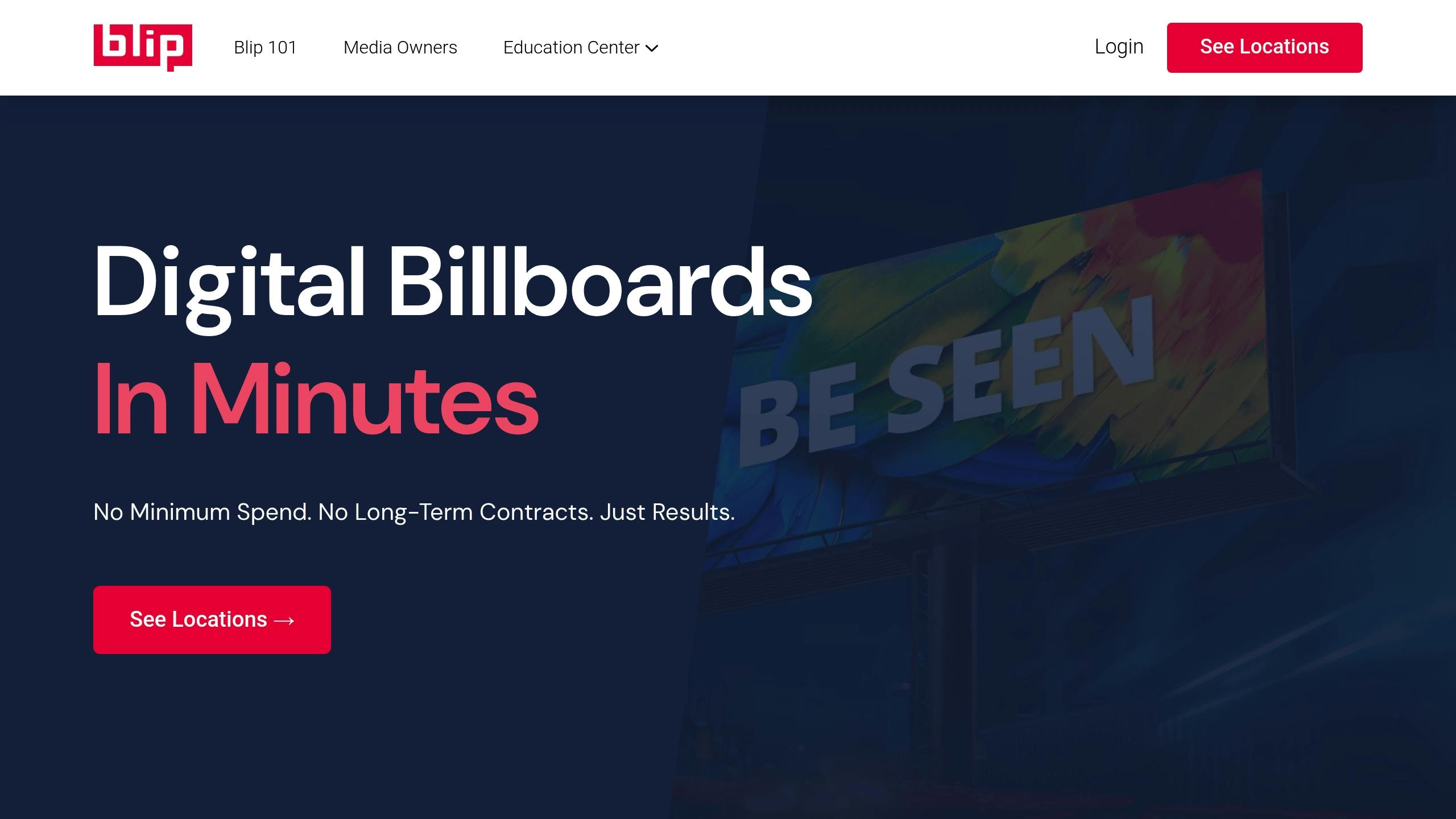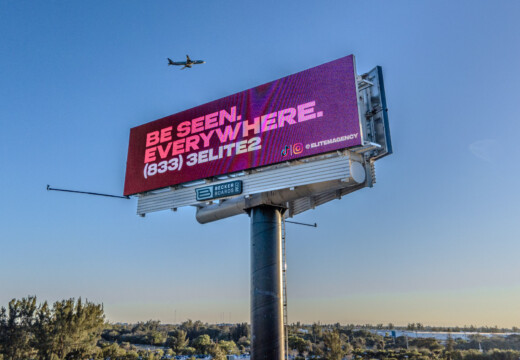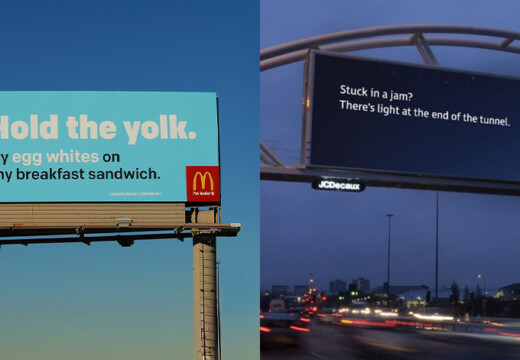Want your billboard to stand out and drive results? Here’s how to pick the perfect spot:
- Traffic Matters: Look for areas with high daily vehicle counts and slow-moving traffic for maximum visibility.
- Know Your Audience: Match billboard locations to local demographics like age, income, and commuting habits.
- Check Competition: Avoid overcrowded areas with too many ads competing for attention.
- Physical Features: Ensure clear visibility with no obstructions, proper lighting, and good alignment with traffic flow.
- Proximity to Business: Place billboards near your store (0–5 miles) to drive foot traffic or further away (5+ miles) to build broader awareness.
- Leverage Data Tools: Use platforms like Blip to analyze traffic patterns, demographics, and ad performance before choosing a spot.
Tip: Consider local events, shopping patterns, and peak traffic hours to time your ads effectively.
Billboard Advertising: How Local Business Can Capitalise From Advertising Outdoors
Know Your Local Market
To get the most out of your billboards, it’s essential to understand your local market. By studying population stats and traffic trends, you can zero in on the best spots to connect with your audience.
Local Population Data
Demographics play a big role in determining how successful your billboard will be. These factors can help you choose the right locations:
| Demographic Factor | Why It Matters | What to Focus On |
|---|---|---|
| Age Distribution | Different age groups travel differently | Areas with a high concentration of your target age group |
| Income Levels | Spending habits vary by income | Match your product’s price range to the area’s income bracket |
| Commute Times | Longer commutes mean more eyes on your ad | Target peak traffic hours and common routes |
| Employment Centers | Work locations influence daily travel | Choose spots near offices or industrial hubs |
Looking beyond just population numbers, it’s also key to understand how people move around the area.
Traffic and Shopping Patterns
Dive into commuting and shopping habits to pinpoint the best exposure times and locations. Here’s what to consider:
Morning Commute Routes
- Focus on major roads leading to business areas.
- Look for spots where traffic slows down.
- Check for clusters of amenities that attract commuters.
Shopping and Traffic Flow
- Map out entrances to major retail areas.
- Factor in seasonal shopping trends.
- Compare weekday and weekend shopping patterns.
- Identify peak shopping hours.
- Watch for traffic spikes during local events.
- Take note of anchor stores that draw consistent crowds.
Local businesses often see better results when their billboards align with these traffic patterns. A well-placed billboard can give you a real edge over competitors.
Check Physical Location Features
The physical aspects of a billboard play a big role in how effectively it connects with the local audience. By understanding the area’s demographics and traffic patterns, you can make sure your ad gets in front of the right people.
Visibility Factors
When choosing a billboard location, prioritize features that make it easy to see. Drivers should be able to spot and understand your message quickly. Good lighting and proper alignment with traffic flow help keep your ad clear. Placing the billboard at a height that avoids obstructions like trees or buildings can also make a big difference. Use market insights to guide how these physical traits can improve ad performance.
High-Traffic Areas
Placing your billboard in busy areas ensures it gets noticed by more people. Locations with heavy traffic are ideal for reaching a broad audience. Key spots to consider include:
- Interstate highways
- Major roads and commuter routes
- Busy commercial districts
- Entrances to shopping centers
- Business parks
- Popular gathering spots
These high-traffic areas are perfect for capturing the attention of a diverse crowd.
Nearby Billboard Competition
Once you’ve secured a location with good visibility and traffic, check out the surrounding area for competing ads. Too many billboards in one spot can dilute your message. Look for locations where there’s enough space between ads so yours can stand out. Proper spacing ensures your billboard grabs attention without getting lost in the mix.
sbb-itb-2e2e93f
Digital Location Planning Tools
Technology has reshaped how advertisers identify and evaluate billboard locations. Today, digital tools offer detailed insights into traffic patterns, demographics, and ad performance, making it easier to make smart decisions.
Maps and Data Tools
Digital mapping platforms allow advertisers to visualize billboard locations in relation to their target audience. These tools merge geographic and demographic data, such as:
- Traffic counts on specific routes
- Population density in nearby areas
- Average household income by neighborhood
- Consumer behavior trends
- Commuter routes and peak travel times
By layering this data onto maps, advertisers can zero in on locations where their audience is most likely to encounter their message, ensuring maximum visibility at the best times.
Using Blip for Location Selection

Blip simplifies the process of choosing billboard locations by combining real-time data with actionable insights. The platform offers tools to help businesses make data-driven decisions.
Key Features of Blip:
| Feature | What It Offers |
|---|---|
| Interactive Map | Easily browse and select billboards from thousands of locations across the U.S. |
| Performance Metrics | Access real-time stats on daily impressions and cost per thousand views (CPM). |
| Dynamic Pricing | Competitive rates through 10-minute bidding cycles. |
| Analytics Dashboard | Monitor and evaluate campaign performance across various locations. |
These tools make it easier than ever to plan billboard campaigns with confidence.
Match Locations to Business Needs
Use digital tools to align your billboard placements with your business goals. Picking the right locations for billboards means ensuring your advertising strategy supports your objectives.
Distance from Your Business
How close a billboard is to your business can directly influence foot traffic and brand awareness. For retail stores, strategic placement can help guide customers to your location.
As Paul Willey shares:
"Working with Blip has given Mr. Charlie’s the momentum to get our new location on the map while accelerating growth for our original location"
Here’s a quick look at how distance impacts billboard effectiveness:
| Distance from Business | Best For | Likely Outcome |
|---|---|---|
| 0-2 miles | Driving foot traffic | More direct visits |
| 2-5 miles | Building local awareness | Stronger brand presence |
| 5-10+ miles | Reaching a broader audience | Attracting customers from farther away |
You can also adjust your placements to take advantage of local events and seasonal opportunities.
Local Event Timing
Syncing your billboard schedule with local events or seasonal trends can boost your visibility. Digital billboards make this easier since they allow for quick updates to match event-driven traffic.
To make the most of event timing:
- Place billboards near event venues during busy seasons.
- Focus on routes leading to popular events or conferences.
- Choose spots near seasonal attractions that draw crowds.
Target Area Coverage
Beyond proximity and event timing, ensure your billboards are placed in areas where your target audience spends their time. This helps you reach the right people more effectively.
Key areas to consider include:
- Main commuter routes during rush hours.
- Entrances to shopping districts.
- Areas near entertainment venues.
- High-visibility spots in business districts.
Conclusion: Location Selection Steps
Choosing the right billboard locations involves weighing several factors to achieve the best results. Thanks to modern digital tools, this process has become more data-focused and efficient, helping advertisers make informed choices without overspending. Success depends on combining location data, audience insights, and the physical characteristics of the placement.
Location Selection Checklist
Evaluate potential billboard locations using the following key factors:
| Evaluation Factor | Key Considerations | Impact on Success |
|---|---|---|
| Traffic Analysis | Daily vehicle count, peak hours, speed limits | Determines impressions and visibility time |
| Demographics | Local population data, commuter patterns, income levels | Ensures the audience matches the target group |
| Physical Features | Viewing distance, lighting, competing signage | Affects how well the message is seen |
| Business Proximity | Distance from store, competitor presence | Impacts conversion opportunities |
| Cost Efficiency | CPM rates, display requirements, flexible scheduling | Helps stretch the budget effectively |
Digital billboards add even more flexibility by allowing advertisers to test and adjust locations based on performance data. This makes it easier to fine-tune strategies while keeping campaigns cost-efficient.


